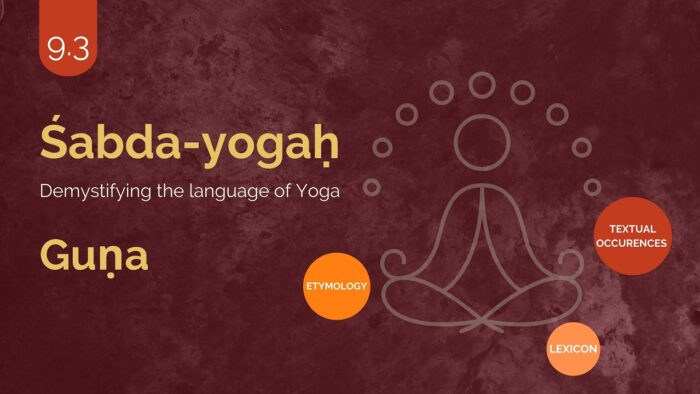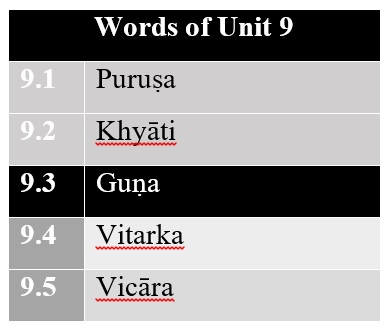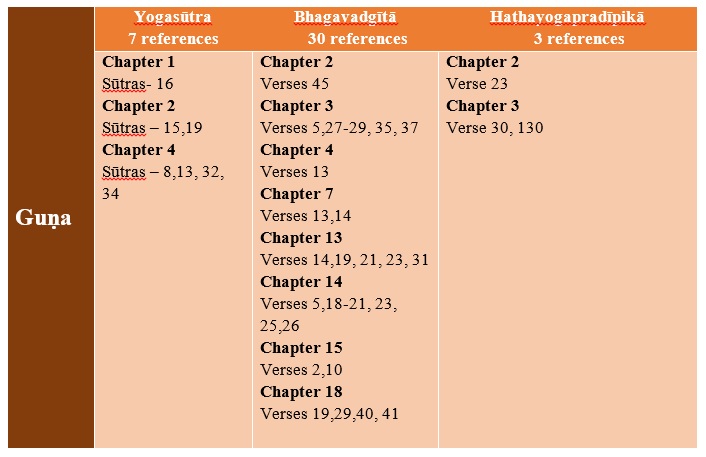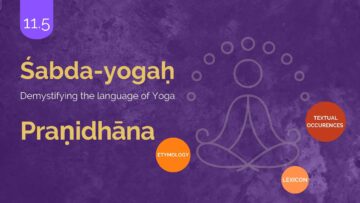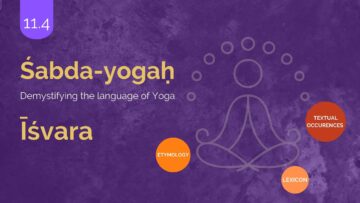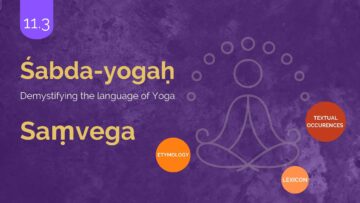Introduction
In this series, Yogic terminologies will be taken up and their –
- Etymological analysis,
- Lexical descriptions and
- Textual occurrences in Yogic literature and their commentaries, as available, will be presented. And finally observations will be made on the references.
Three texts – Yogasūtra, Haṭha-yoga-pradīpikā and Bhagavad-gītā are consulted for textual occurrences portion.
Śabda-yoga is intended to help students, teachers, and professionals of Yoga to develop a sound grammatical, contextual, and thereby an authentic and immersive understanding of Yoga terminologies.
List of Words
From among the above five words for this unit 9, this part discusses the third word Guṇa.
Etymology
गुण+ अच्/घञ् = गुणः
guṇa+ac/ ghañ= guṇaḥ
- गुणGuṇa is the root that means आमन्त्रणāmantraṇa– to invite, to call, to speak intelligently
- the two possible suffixes to this word are –
- ac – this means the कर्ताkartā doer – this is added based on the grammar rule नन्दिग्रहिपचादिभ्योल्युणिन्यचःnandigrahipacādibhyolyuṇinyacaḥ (aṣṭādhyāyī3.3.134)
- ghañ – this means भावbhāva the act – this is added based on the grammar rule भावेbhāve (aṣṭādhyāyī 3.3.18)
Based on the above two possible suffixes two derivations are possible –
- If the suffix is ac – then the derivation would be – गुणयतिइतिगुणः – guṇayatiitiguṇaḥ – the one who/that invites
- If the suffix is ghañ – then the derivation would be – गुण्यतेइतिगुणः – guṇyateitiguṇaḥ – the act of inviting or calling
It is evident that from the above derivations – in the context of Yogic utilization of the term, the etymological derivation is of not much use. The meaning of the word guṇa that we see in Yogic context is based on convention and context more than the etymology.
Lexicon
In amarakośa there are four references to this word –
1) मोर्वीज्याशिञ्जिनीगुणः – 2.8.85
morvījyāśiñjinīguṇaḥ
The words morvī, jyā, śiñjinīand guṇa refer to the string of the bow
2) आरालिकाआन्धसिकाःसूदाऔदनिकागुणाः – 2.9.28
ārālikāāndhasikāḥsūdāaudanikāguṇāḥ
The words ārālika, āndhasika, sūda, audanika and guṇa are all synonyms that indicate the meaning – a cook.
3) शुल्बंवराटकंस्त्रीतुरज्जुस्त्रिषुवटीगुणः – 2.10.27
śulbaṃvarāṭakaṃstrīturajjustriṣuvaṭīguṇaḥ
The words śulba, varāṭakastrīturajjustriṣuvaṭīguṇa, all these words refer to a string/cord.
4) मौर्व्यांद्रव्याश्रितेसत्वशौर्यसन्ध्यादिकेगुणः – 3.3.47
maurvyāṃdravyāśritesatvaśauryasandhyādikeguṇaḥ
The word guṇa means – the bow string, the quality/characteristic of a substance like color etc, Sattva, Rajas and Tamas, Valour and 6 principles of dealing with constituent states that include – sandhi (peace), vigraha (hostility), āsana (remaining quiet), yāna (military expedition), saṃśraya (seeking shelter) and dvaidhībhāva (a combination of sandhi and vigraha).
Among the four references above, the fourth collects all the possible connotations of the word. It would be interesting to see from among these, the meanings adopted by the Yoga texts.
Textual occurrences
Yogasūtra
There are 7 references to the word in the Yogasūtras. As could be noted – excepting the third chapter, Guṇa is found in the other three chapters. Interestingly, majority of the references are from the fourth chapter (4 occurrences) –
Pāda 1
तत्परंपुरुषख्यातेर्गुणवेतृष्ण्यम्॥१.१६॥
tatparaṃpuruṣakhyāterguṇavetṛṣṇyam.. 1.16 ..
In the lone reference from this chapter it could be seen that the higher Vairāgya is achieved by become dispassionate about the workings of the Guṇas (Sattva, Rajas and Tamas) by having a direct perception of the consciousness.
Pāda 2
परिणामतापसंस्कारदुःखैर्गुणवृत्तिविरोधाच्चदुःखमेवसर्वंविवेकिनः॥२.१५॥
विशेषाविशेषलिङ्गमात्रालिङ्गानिगुणपर्वाणि॥२.१९॥
pariṇāmatāpasaṃskāraduḥkhairguṇavṛttivirodhāccaduḥkhamevasarvaṃvivekinaḥ .. 2.15..
viśeṣāviśeṣaliṅgamātrāliṅgāniguṇaparvāṇi .. 2.19 ..
In sūtra 2.15 Guṇavṛttivirodhā – the mutual conflicting nature of functioning of the three Guṇas – Sattva, Rajas and Tamas – is stated as one among the cause of everything being a suffering for a Vivekin (a person with capability to think with discriminative capability).
The expression – guṇaparva – in Sūtra 2.19 – indicates that all the aspects of the creation – subtle to gross – are only stages (parva) of manifestation Guṇas.
Pāda4
ततस्तद्विपाकानुगुणानामेवाभिव्यक्तिर्वासनानाम्॥४.८॥
तेव्यक्तसूक्ष्मागुणात्मानः॥४.१३॥
ततःकृतार्थानांपरिणामक्रमसमाप्तिर्गुणानाम्॥४.३२॥
पुरुषार्थशून्यानांगुणानांप्रतिप्रसवःकैवल्यंस्वरूपप्रतिष्ठावाचितिशक्तिरिति॥४.३४॥
tatastadvipākānuguṇānāmevābhivyaktirvāsanānām .. 4.8 ..
tevyaktasūkṣmāguṇātmānaḥ .. 4.13 ..
tataḥkṛtārthānāṃpariṇāmakramasamāptirguṇānām .. 4.32 ..
puruṣārthaśūnyānāṃguṇānāṃpratiprasavaḥkaivalyaṃsvarūpapratiṣṭhāvācitiśaktiriti .. 4.34 ..
In Sūtra 4.8 the expression anuguṇa is noticed, which means – accordingly. This word has nothing to do with the three Guṇas. According (anuguṇa) to the Vipāka – – fruition of the Karmas – relevant Vāsanas will manifest to help function as specific life form – in that birth.
The expression guṇātman in the Sūtra 4.13 – indicates that – all the creation is of the nature of the three Guṇas only. The creation in the present -is manifest Guṇas and the past &future creations are in the form of un-manifest Guṇas.
In Sūtra 4.32 the end of pariṇāmakrama – mutating sequence – of the guṇas happens – on the attainment of the state of Dharmameghasamādhi is described.
Sūtra 4.34 continues about the fate of the Guṇas after the attainment of the Dharmameghasamādhi. After the end of the mutating sequence of Guṇas– the Guṇas see that purpose of serving of the Puruṣa (puruṣārthaśūnyā) no more exists. And consequently Guṇas– finally attain pratiprasava – rolling back into their causal state.
Bhagavadgītā
The Bhagavadgītā also has rich references on the Guṇas. There 30 references spread across 8 chapters (Chapters 2, 3, 4, 7, 13, 14, 15 & 18). A chapter-wise summary of the references is presented hereunder.
Chapter 2
त्रैगुण्यविषयावेदानिस्त्रैगुण्योभवार्जुन।
निर्द्वन्द्वोनित्यसत्त्वस्थोनिर्योगक्षेमआत्मवान्॥२.४५॥
traiguṇyaviṣayāvedānistraiguṇyobhavārjuna .
nirdvandvonityasattvasthoniryogakṣemaātmavān .. 2.45 ..
In this very first reference to the Guṇas in the Bhagavadgītā– Śrīkṛṣṇa states that the Vedas (that portion of the Vedas which speaks about the Karmas – rituals etc) are in the realm of the Guṇas. One should transcend them and become free from the influence of the Guṇas.
Chapter 3
नहिकश्चित्क्षणमपिजातुतिष्ठत्यकर्मकृत्।
कार्यतेह्यवशःकर्मसर्वःप्रकृतिजैर्गुणैः॥३.५॥
प्रकृतेःक्रियमाणानिगुणैःकर्माणिसर्वशः।
अहङ्कारविमूढात्माकर्ताहमितिमन्यते॥३.२७॥
तत्त्ववित्तुमहाबाहोगुणकर्मविभागयोः।
गुणागुणेषुवर्तन्तइतिमत्वानसज्जते॥३.२८॥
प्रकृतेर्गुणसंमूढाःसज्जन्तेगुणकर्मसु।
तानकृत्स्नविदोमन्दान्कृत्स्नविन्नविचालयेत्॥३.२९॥
श्रेयान्स्वधर्मोविगुणःपरधर्मात्स्वनुष्ठितात्।
स्वधर्मेनिधनंश्रेयःपरधर्मोभयावहः॥३.३५॥
कामएषक्रोधएषरजोगुणसमुद्भवः।
महाशनोमहापाप्माविद्ध्येनमिहवैरिणम्॥३.३७॥
na hi kaścitkṣaṇamapijātutiṣṭhatyakarmakṛt .
kāryatehyavaśaḥ karma sarvaḥprakṛtijairguṇaiḥ .. 3.5 ..
prakṛteḥkriyamāṇāniguṇaiḥkarmāṇisarvaśaḥ .
ahaṅkāravimūḍhātmākartāhamitimanyate .. 3.27 ..
tattvavittumahābāhoguṇakarmavibhāgayoḥ .
guṇāguṇeṣuvartantaitimatvānasajjate .. 3.28 ..
prakṛterguṇasaṃmūḍhāḥsajjanteguṇakarmasu .
tānakṛtsnavidomandānkṛtsnavinnavicālayet .. 3.29 ..
śreyānsvadharmoviguṇaḥparadharmātsvanuṣṭhitāt .
svadharmenidhanaṃśreyaḥparadharmobhayāvahaḥ .. 3.35 ..
kāmaeṣakrodhaeṣarajoguṇasamudbhavaḥ .
mahāśanomahāpāpmāviddhyenamihavairiṇam .. 3.37 ..
In these 6 reference three types of descriptions to the Guṇas can be noted –
1) prakṛtijairguṇaiḥ (3.5), prakṛteḥ… guṇaiḥ (3.27), guṇakarmavibhāga , guṇāguṇeṣuvartanta (3.28), prakṛterguṇa (3.29) – These references point to the fact that the three Guṇas – Sattva, Rajas and Tamas belong to the primordial matter (prakṛti) and all the actions and consequences are in the realm of prakṛti. The consciousness is different from this.
2) svadharmoviguṇaḥ (3.35) – Here the expression Viguṇa is to be understood as bereft of quality. Śrīkṛṣṇa advices that even if one’s own dharma may be of bereft of quality – one should stick to one’s Dharma only. Here it has to be noted that the word Guṇa is not related to Sattva-Rajas-Tamas.
3) Rajoguṇa (3.37) – In this verse Rajoguṇa is stated as the cause of desire and anger.
Chapter 4
चातुर्वर्ण्यंमयासृष्टंगुणकर्मविभागशः।
तस्यकर्तारमपिमांविद्ध्यकर्तारमव्ययम्॥४.१३॥
cāturvarṇyaṃmayāsṛṣṭaṃguṇakarmavibhāgaśaḥ .
tasyakartāramapimāṃviddhyakartāramavyayam .. 4.13 ..
Here it has been clarified by Śrīkṛṣṇa that – the four Varṇa-system is created based on the (three) Guṇas and the Karma connected to them.
Chapter 7
त्रिभिर्गुणमयैर्भावैरेभिःसर्वमिदंजगत्।
मोहितंनाभिजानातिमामेभ्यःपरमव्ययम्॥७.१३॥
दैवीह्येषागुणमयीमममायादुरत्यया।
मामेवयेप्रपद्यन्तेमायामेतांतरन्तिते॥७.१४॥
tribhirguṇamayairbhāvairebhiḥsarvamidaṃjagat .
mohitaṃnābhijānātimāmebhyaḥparamavyayam .. 7.13 ..
daivīhyeṣāguṇamayī mama māyāduratyayā .
māmeva ye prapadyantemāyāmetāṃtarantite .. 7.14 ..
Both these verses in the chapter refer to the three Guṇas. The entire world is deluded by the acts of the three Guṇas and the Māya/illusion is also made up of the three Guṇas.
Chapter 13
सर्वेन्द्रियगुणाभासंसर्वेन्द्रियविवर्जितम्।
असक्तंसर्वभृच्चैवनिर्गुणंगुणभोक्तृच॥१३.१४॥
प्रकृतिंपुरुषंचैवविद्ध्यनादीउभावपि।
विकारांश्चगुणांश्चैवविद्धिप्रकृतिसम्भवान्॥१३.१९॥
पुरुषःप्रकृतिस्थोहिभुङ्क्तेप्रकृतिजान्गुणान्।
कारणंगुणसङ्गोऽस्यसदसद्योनिजन्मसु॥१३.२१॥
यएवंवेत्तिपुरुषंप्रकृतिंचगुणैःसह।
सर्वथावर्तमानोऽपिनसभूयोऽभिजायते॥१३.२३॥
अनादित्वान्निर्गुणत्वात्परमात्मायमव्ययः।
शरीरस्थोऽपिकौन्तेयनकरोतिनलिप्यते॥१३.३१॥
sarvendriyaguṇābhāsaṃsarvendriyavivarjitam .
asaktaṃsarvabhṛccaivanirguṇaṃguṇabhoktṛ ca .. 13.14 ..
prakṛtiṃpuruṣaṃcaivaviddhyanādīubhāvapi .
vikārāṃścaguṇāṃścaivaviddhiprakṛtisambhavān .. 13.19 ..
puruṣaḥprakṛtistho hi bhuṅkteprakṛtijānguṇān .
kāraṇaṃguṇasaṅgo’syasadasadyonijanmasu .. 13.21 ..
yaevaṃvettipuruṣaṃprakṛtiṃ ca guṇaiḥsaha .
sarvathāvartamāno’pinasabhūyo’bhijāyate .. 13.23 ..
anāditvānnirguṇatvātparamātmāyamavyayaḥ .
śarīrastho’pikaunteyanakarotinalipyate .. 13.31 ..
Except the expression – Indriyaguṇābhāsa (13.14) – which indicates that – the consciousness is seen as if it resembles the qualities (guṇa) of the senses – all other appearances of the word guṇa in this chapter point to the workings of the three Guṇas – Sattva-Rajas-Tamas in this manifest universe and how the consciousness is distinct from that.
Chapter 14
सत्त्वंरजस्तमइतिगुणाःप्रकृतिसम्भवाः।
निबध्नन्तिमहाबाहोदेहेदेहिनमव्ययम्॥१४.५॥
ऊर्ध्वंगच्छन्तिसत्त्वस्थामध्येतिष्ठन्तिराजसाः।
जघन्यगुणवृत्तस्थाअधोगच्छन्तितामसाः॥१४.१८॥
नान्यंगुणेभ्यःकर्तारंयदाद्रष्टानुपश्यति।
गुणेभ्यश्चपरंवेत्तिमद्भावंसोऽधिगच्छति॥१४.१९॥
गुणानेतानतीत्यत्रीन्देहीदेहसमुद्भवान्।
जन्ममृत्युजरादुःखैर्विमुक्तोऽमृतमश्नुते॥१४. २०॥
कैर्लिङ्गैस्त्रीन्गुणानेतानतीतोभवतिप्रभो।
किमाचारःकथंचैतांस्त्रीन्गुणानतिवर्तते॥१४.२१॥
उदासीनवदासीनोगुणैर्योनविचाल्यते।
गुणावर्तन्तइत्येवयोऽवतिष्ठतिनेङ्गते॥१४.२३॥
मानापमानयोस्तुल्यस्तुल्योमित्रारिपक्षयोः।
सर्वारम्भपरित्यागीगुणातीतःसउच्यते॥१४. २५॥
मांचयोऽव्यभिचारेणभक्तियोगेनसेवते।
सगुणान्समतीत्यैतान्ब्रह्मभूयायकल्पते॥१४.२६॥
sattvaṃrajastamaitiguṇāḥprakṛtisambhavāḥ .
nibadhnantimahābāhodehedehinamavyayam .. 14.5 ..
ūrdhvaṃgacchantisattvasthāmadhyetiṣṭhantirājasāḥ .
jaghanyaguṇavṛttasthāadhogacchantitāmasāḥ .. 14.18 ..
nānyaṃguṇebhyaḥkartāraṃyadādraṣṭānupaśyati .
guṇebhyaścaparaṃvettimadbhāvaṃso’dhigacchati .. 14.19 ..
guṇānetānatītyatrīndehīdehasamudbhavān .
janmamṛtyujarāduḥkhairvimukto’mṛtamaśnute .. 14. 20 ..
kairliṅgaistrīnguṇānetānatītobhavatiprabho .
kimācāraḥkathaṃcaitāṃstrīnguṇānativartate .. 14.21 ..
udāsīnavadāsīnoguṇairyonavicālyate .
guṇāvartantaityevayo’vatiṣṭhatineṅgate .. 14.23 ..
mānāpamānayostulyastulyomitrāripakṣayoḥ .
sarvārambhaparityāgīguṇātītaḥsaucyate .. 14. 25 ..
māṃ ca yo’vyabhicāreṇabhaktiyogenasevate .
saguṇānsamatītyaitānbrahmabhūyāyakalpate .. 14.26 ..
The very chapter 14 is known as Guṇa-traya-vibhaga-yoga hence most of the references on the Guṇas are seen from this chapter. Verse 14.15 states that there are three Guṇas – Sattva-Rajas-Tamas. Their source is Prakṛti.
Tamas is described as Jaghanya-guṇa – the lowly among the three Guṇas in verse 14.18.
Verse 14.19 & 14.20 states that all actions are done by the Guṇas and one should transcend these and see beyond them to attain freedom from aging and death and by that reach immortality.
Verses 14.21,23. 25 & 26 – discuss Guṇatita – the one who has transcended the three Guṇas. The what and how of it is discussed in these verses.
Chapter 15
अधश्चोर्ध्वंप्रसृतास्तस्यशाखागुणप्रवृद्धाविषयप्रवालाः।
अधश्चमूलान्यनुसन्ततानिकर्मानुबन्धीनिमनुष्यलोके॥१५.२॥
उत्क्रामन्तंस्थितंवापिभुञ्जानंवागुणान्वितम्।
विमूढानानुपश्यन्तिपश्यन्तिज्ञानचक्षुषः॥१५.१०॥
adhaścordhvaṃprasṛtāstasyaśākhāguṇapravṛddhāviṣayapravālāḥ .
adhaścamūlānyanusantatānikarmānubandhīnimanuṣyaloke .. 15.2 ..
utkrāmantaṃsthitaṃvāpibhuñjānaṃvāguṇānvitam .
vimūḍhānānupaśyantipaśyantijñānacakṣuṣaḥ .. 15.10 ..
In verse 15.2 it has been stated that the branches of the tree of worldly existence have been nourished by the three Guṇas.
Verse 15.10 instructs that those who are endowed with Viveka can recognize the consciousness as that which is experiencing the Guṇas, while those who are deluded cannot see the consciousness in this context. The word Guṇa in the expression guṇānvitam in this verse has been interpreted by ācāryaśaṅkarabhagavatpāda as – सुखदुःखमोहाद्यैःगुणैःअन्वितम् – sukhaduḥkhamohādyaiḥguṇaiḥanvitam – comfort, suffering and delusion are described as Guṇas, which are experienced by the consciousness.
Chapter 18
ज्ञानंकर्मचकर्ताचत्रिधैवगुणभेदतः।
प्रोच्यतेगुणसङ्ख्यानेयथावच्छृणुतान्यपि॥१८.१९॥
बुद्धेर्भेदंधृतेश्चैवगुणतस्त्रिविधंशृणु।
प्रोच्यमानमशेषेणपृथक्त्वेनधनञ्जय॥१८.२९॥
नतदस्तिपृथिव्यांवादिविदेवेषुवापुनः।
सत्त्वंप्रकृतिजैर्मुक्तंयदेभिःस्यात्त्रिभिर्गुणैः॥१८.४०॥
ब्राह्मणक्षत्रियविशांशूद्राणांचपरन्तप।
कर्माणिप्रविभक्तानिस्वभावप्रभवैर्गुणैः॥१८.४१॥
श्रेयान्स्वधर्मोविगुणःपरधर्मात्स्वनुष्ठितात्।
स्वभावनियतंकर्मकुर्वन्नाप्नोतिकिल्बिषम्॥१८.४७॥
jñānaṃ karma ca kartā ca tridhaivaguṇabhedataḥ .
procyateguṇasaṅkhyāneyathāvacchṛṇutānyapi .. 18.19 ..
buddherbhedaṃdhṛteścaivaguṇatastrividhaṃśṛṇu .
procyamānamaśeṣeṇapṛthaktvenadhanañjaya .. 18.29 ..
natadastipṛthivyāṃvādivideveṣuvāpunaḥ .
sattvaṃprakṛtijairmuktaṃyadebhiḥsyāttribhirguṇaiḥ .. 18.40 ..
brāhmaṇakṣatriyaviśāṃśūdrāṇāṃ ca parantapa .
karmāṇipravibhaktānisvabhāvaprabhavairguṇaiḥ .. 18.41 ..
śreyānsvadharmoviguṇaḥparadharmātsvanuṣṭhitāt .
svabhāvaniyataṃ karma kurvannāpnotikilbiṣam .. 18.47 ..
In verses 18.19,29, 40, 41 – the impact of three Guṇas in various aspects of worldly life is described. This includes – jñānaṃ (knowledge), karma (action), kartā (doer), Buddhi (intellect), dhṛti (fortitude), the actions of Brāhmaṇa, Kṣatriya, vaiśhya & śūdras.
Just like in verse 3.35 in verse 18.47 we see the expression viguṇa. The meaning remains the same as in the earlier context which can be seen under chapter 3 discussion.
Haṭhayogapradīpikā
In this text there are 3 References to the word Guṇa.
कर्मषट्कमिदंगोप्यंघटशोधनकारकम्।
विचित्रगुणसन्धायिपूज्यतेयोगिपुङ्गवैः॥२.२३॥
एतत्त्रयंमहागुह्यंजरामृत्युविनाशनम्।
वह्निवृद्धिकरंचैवह्यणिमादिगुणप्रदम्॥३.३०॥
तस्यवाक्यपरोभूत्वामुद्राभ्यासेसमाहितः।
अणिमादिगुणैःसार्धंलभतेकालवञ्चनम्॥३.१३०॥
karmaṣaṭkamidaṃgopyaṃghaṭaśodhanakārakam .
vicitraguṇasandhāyipūjyateyogipuṅgavaiḥ .. 2.23 ..
etattrayaṃmahāguhyaṃjarāmṛtyuvināśanam .
vahnivṛddhikaraṃcaivahyaṇimādiguṇapradam .. 3.30 ..
tasyavākyaparobhūtvāmudrābhyāsesamāhitaḥ .
aṇimādiguṇaiḥsārdhaṃlabhatekālavañcanam .. 3.130 ..
Of the three references the first reference vicitraguṇa (2.23) – according to the commentary Jyotsnā refers to the 6 types of cleansing activity (विचित्रंविलक्षणंगुणंषट्कर्मरूपम्- Vicitraṃvilakṣaṇaṃguṇaṃṣaṭkarmarūpam)
In other two verses the expression aṇimādiguṇa (3.30&130) is seen. As evident – it points to the 8 super natural powers attained by the practice of Yoga.
Tabulation on Distribution of References in Yoga Texts
Observations
It could be noted that in Yogasūtras and Bhagavadgītā the word Guṇas have been used predominantly to point to the three Guṇas and their impact in worldly life and its relation to the consciousness. To summarize – eleven aspects related to three Guṇas that have emerged. They include –
- Prakṛti is the source of the Guṇas
- The three Guṇas are of mutually opposing nature
- The manifest universe, the constituents of the universe in the past, present and future and the actions therein are constituted by the three Guṇas only
- The nomenclature of the three Guṇas and their functions
- The human society is organized into four Varnas based on the Guṇas
- Role of Guṇas in causing suffering, anger and desire
- How Guṇas influence various aspects of our life including – jñānaṃ (knowledge), karma (action) , kartā (doer), Buddhi (intellect), dhṛti (fortitude) etc
- The need to transcend the Guṇas and the ways and means of doing it
- Need of dispassion in the Guṇas in pursuit of higher vairāgya
- Consciousness does not fall in the realm of the Guṇas
- The rolling back of the Guṇas into their causal state – in the process of reaching Kaivalya-liberation
Interestingly in Haṭhayogapradīpikā – the word Guṇa does not point to the three Guṇas. Even in the Bhagavadgītā and Yogasūtras we see the usage of the word Guṇa and its derivatives in other meanings also. The meaning of the Guṇas other than Sattva-Rajas and Tamas– in these texts – are collected here under for clarity –
1) Guṇa
- The Eight super natural powers beginning from anima etc. (HYP2.23)
- The six acts of cleanings – like Dhauti Vastineti etc. (3.33& 130)
2) Anuguṇa – accordingly (YS 4.8)
3) Viguṇa – bereft of virtues (BG 3.35 & 18.47)
4) Indriyaguṇa – nature/ quality of the senses (BG 13.14)
Thus it could be observed that Guṇa is a very important expression in the Yoga texts. While it is prevalently used in the sense of the three Guṇas – there are also other connotations to this term which are to be carefully understood and interpreted in teaching/learning processes. These rich inputs and discussions thus bring out the utility of the Śabda-yoga series.
Unit 9 To be Continued…
Links for previous posts in this unit
Disclaimer: The opinions expressed in this article belong to the author. Indic Today is neither responsible nor liable for the accuracy, completeness, suitability, or validity of any information in the article.

